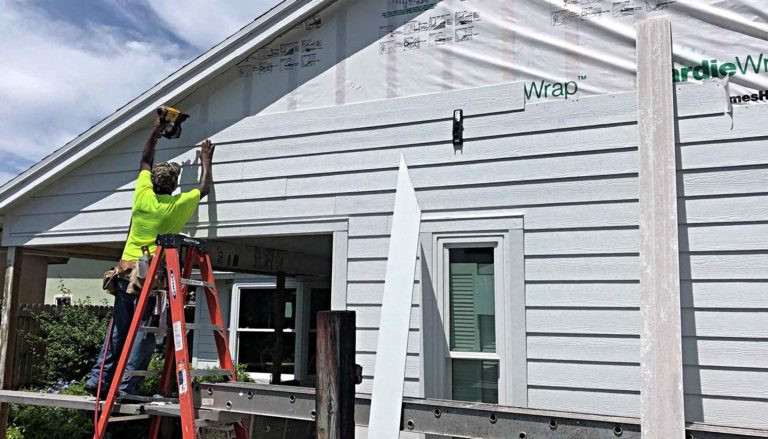South Florida’s climate and location present special challenges for keeping our homes and businesses comfortable and attractive throughout the year and over the long haul. Beating sun, frequent rain, salt air, and the threat of hurricanes make the selection of siding material for your house, store, and office a critical decision. You want a material that will not only protect your investment but also look nice, add value, and not require you to spend every weekend maintaining it.
That’s why Holeman wholeheartedly recommends Hardie Board fiber cement siding to all our customers
What’s So Great about Fiber Cement Siding?
Humans have appreciated wood’s natural beauty and rich luxury for millennia. Its intricate grain and sleek finishes give our furniture and living spaces a hominess and richness that is hard to match. Cement, on the other hand, conjures images of a tough, no-nonsense compound that serves as a barrier against impact, storm surges, and other forces that can destroy lesser materials. Fiber cement siding combines the beauty of wood with the strength and fire resistance of cement to give buildings a resilient, aesthetically pleasing cover. This best-of-both-worlds material embeds the wood fibers in the cement, allowing the simulated grain to show through the tough-yet-flexible cement bonding medium. While it runs circles around aluminum and most other siding products, all-fiber cement siding is not created equal. James Hardie does nothing but makes fiber cement lap siding, panels, and planks. The company’s 5/16-inch thick construction and baked-on through colors exceed industry standards for durability and quality. Here’s how:
What Makes Hardie Board Perfect for South Florida?
As noted, the combination of wood fiber and cement gives James Hardie fiber cement siding a character and performance that outshines all other materials and brands.
Impervious to Moisture
South Florida is the most humid region in the United States. All that moisture in the air is constantly on the lookout for a place to condense. Hardie Board repels humidity and sea mist, keeping it away from your home’s framing and infrastructure. Hardie Board keeps mold-, mildew-, and rot-causing water away in two ways. First, the professional installation allows panels to expand and contract with the temperature without creating gaps through which water can enter. Second, a Hardiwrap® barrier allows the house to breathe and expel any moisture that creeps into the space between the Hardie Board and the outside of the interior walls.

Hurricane-tested
Miami-Dade and Broward counties have adopted stringent high-velocity hurricane zone (HVHZ) requirements into their building codes. For 30 years, these codes have required that homes built here comply with wind-pressure and rain-penetration standards. Hardie Board provides comprehensive manufacturing process and product specifications to the counties and continually tests its products to ensure they can stand up to hurricanes.
Environmentally Friendly
Because Hardie Board is constructed from renewable and easily sourced components, collecting the raw materials exerts little pressure on the environment. And since the installed Hardie Board can be cleaned with mild soap and a little water, there are no harsh chemicals that can be absorbed into the ground.
Durable
Hardie Board not only resists fire and moisture but also deters insects and maintains its vivid color through decades of exposure to ultraviolet light. It requires repainting far less often than traditional wood cladding and if you do want a change of scenery, it covers easily with any exterior acrylic latex paint.
While all this sounds too good to be true, there are a couple of caveats for people considering replacing their siding with James Hardie fiber cement. First, it costs somewhat more than aluminum and vinyl siding. This is due to the craftsmanship and quality materials involved in the manufacturing process. This higher upfront cost is offset, however, by fiber cement siding’s lower maintenance cost and the additional resale value it gives to your home.
Labor costs also are a bit higher for Hardie Board installation owing to the skill and specialized expertise required. It is harder to handle and less forgiving than other siding materials, necessitating larger crews to complete the job promptly. Because of this, owners should trust their project only to qualified Hardie Board installers. For instance, Holeman is a James Hardie Elite Preferred contractor, meaning the manufacturer certifies that Holeman adheres to all its recommended installation methods and quality control guidelines.
Replacing the siding on your home or business is one of the most cost-efficient ways to upgrade your lifestyle and add color and variety to your living space. Skilled, knowledgeable installation can ensure the process runs smoothly and ensure you get the most out of your new siding for years on end. To learn more about how Hardie siding and Holeman professional installation can transform your home into a showplace, contact us to get started!
